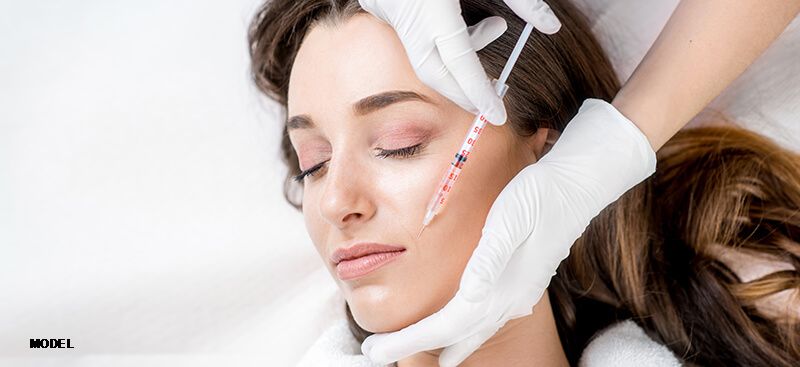Botox Maintenance: How Often Will I Need Treatments?

Botox and similar agents such as Dysport, Xeomin and Daxxify, are the gold standard of anti-aging, offering truly transformative results in the ongoing battle against fine lines and wrinkles. With their ability to address severe wrinkles without the pain or downtime of plastic surgery, Botox and similar agents only have one shortfall: the results are not permanent. Fortunately, it is possible to extend the life of these results over the long-term by undergoing periodic “maintenance” treatment sessions.
For simplicity we will refer to this collective group of botulinum toxin treatment options as “Botox.” In this blog post we will shed light on the inner workings of Botox, the duration of its results, and the importance of a personalized long-term strategy to keep patients looking their best.
How Botox Works
Botox, short for botulinum toxin, works by temporarily blocking the nerve signals that cause muscles to contract. When injected into specific facial muscles, Botox disrupts the communication between nerves and muscles, preventing the muscles from contracting as forcefully. This temporary paralysis or weakening of the muscles reduces the appearance of wrinkles and fine lines caused by repetitive facial movements, such as smiling, frowning, or squinting.
Typical Botox Result Duration
One of the most common queries regarding Botox pertains to the duration of its effects. On average, Botox results typically last between three to four months. However, individual factors such as metabolism, muscle strength, injection technique, and less commonly antibodies against the product can influence the longevity of results. While some may experience results lingering closer to the three-month mark, others might enjoy the benefits for up to four months.
Extending Results: How Often Should You Get Botox?
Botox results can be extended over longer periods of time with periodic maintenance treatment sessions. The frequency of Botox treatments largely depends on individual factors and desired outcomes. While the standard interval between treatments is approximately three to four months, some individuals may find that their facial muscles adapt over time, requiring less frequent injections. This adaptation occurs when muscles become trained to contract less, thus prolonging the efficacy of each treatment. Consequently, the ideal interval between treatments may vary, necessitating a personalized approach tailored to each patient’s unique physiology and aesthetic goals.
Long-Term Botox Strategy
Crafting an effective long-term maintenance strategy is crucial for maximizing the benefits of Botox while minimizing the need for frequent injections. Since the optimal interval between treatments can vary from person to person, collaborating closely with a qualified cosmetic practitioner is paramount. A skilled clinician can assess individual responses to Botox, monitor changes in muscle behavior, and adjust treatment plans accordingly. By trusting your provider to devise a customized strategy, you can ensure consistent results while avoiding over-treatment and unnecessary risks.
Why It’s Important Not to “Overdo it”
Overdoing Botox injections can lead to a range of undesirable outcomes, both aesthetic and functional. Here are some potential consequences of excessive Botox treatment:
Frozen expression: Injecting too much Botox can result in a frozen or immobile appearance, where facial muscles lose their ability to move naturally. This can give the face a rigid, mask-like appearance, detracting from its natural expressiveness.
Limited facial expressions: Botox works by temporarily paralyzing or weakening targeted muscles, which can impede normal facial expressions. Overdoing Botox injections may restrict the range of facial movements, making it difficult to convey emotions effectively.
Uneven results: Excessive Botox in certain areas of the face can lead to asymmetrical results, where one side appears different from the other. This imbalance can be particularly noticeable in features like the eyebrows or lips.
Drooping eyelids or brow: If Botox spreads beyond the intended treatment area, it can affect nearby muscles, causing drooping eyelids or eyebrows. This phenomenon, known as ptosis, occurs when muscles responsible for lifting the eyelids or eyebrows are inadvertently weakened.
Difficulty speaking or eating: In rare cases, over-injecting Botox around the mouth or neck area can affect speech and chewing abilities. Excessive paralysis of facial and neck muscles involved in these functions can result in speech impediments or difficulty with chewing and swallowing.
Headaches or discomfort: Some individuals may experience headaches or discomfort following Botox injections. This can occur due to muscle tension or changes in facial sensation. These symptoms typically improve on their own but warrant investigation with your injector if symptoms persist beyond a few days.
Complications: While rare, overdoing Botox injections can increase the risk of complications such as allergic reactions, infection at the injection site, or unintended spread of the toxin to adjacent areas. These complications may necessitate medical intervention to address and resolve. Counterfeit versions of Botox are unfortunately circulating in multiple states and the side effects can be dangerous if not lethal in the wrong hands. It is important to seek treatment from reputable medical practitioners who obtain their Botox and related treatments directly from Botox manufacturers (i.e., AbbVie, Galderma, Merz, Evolus, etc.).
It’s crucial to emphasize that the likelihood of experiencing these adverse effects increases with the quantity and frequency of Botox injections. Therefore, it is essential to work closely with a qualified and experienced healthcare provider utilizing safe, FDA approved treatments who can assess your individual needs each encounter, administer the appropriate dosage, and ensure optimal outcomes while minimizing the risk of complications. Additionally, maintaining open communication with your provider about your aesthetic goals and concerns is key to achieving satisfactory results with Botox treatment.
While Botox offers remarkable rejuvenating effects, maintaining its benefits requires a personalized approach. By understanding how Botox works, the duration of its results, and the importance of a tailored long-term strategy, patients can navigate their journey toward a more natural and youthful appearance with confidence and informed decision-making.
Disclaimer: The contents of the Westlake Dermatology website, including text, graphics, and images, are for informational purposes only and are not intended to substitute for direct medical advice from your physician or other qualified professional.
